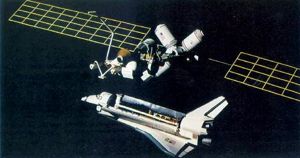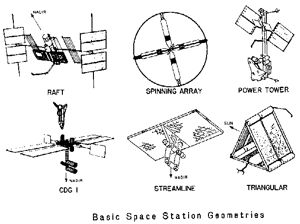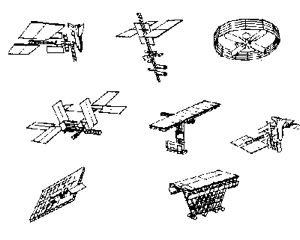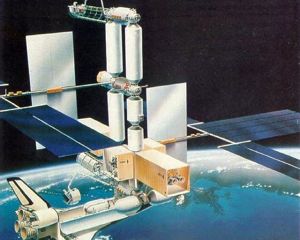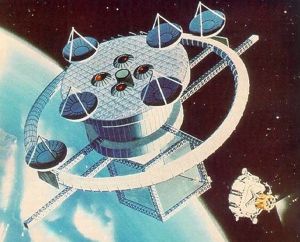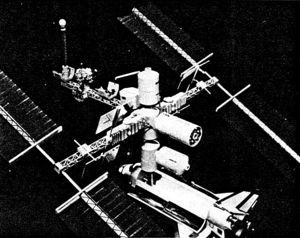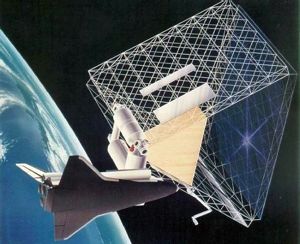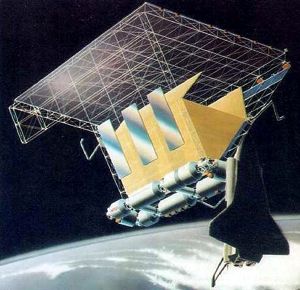
Home - Search - Browse - Alphabetic Index: 0- 1- 2- 3- 4- 5- 6- 7- 8- 9
A- B- C- D- E- F- G- H- I- J- K- L- M- N- O- P- Q- R- S- T- U- V- W- X- Y- Z
Space Station 1984
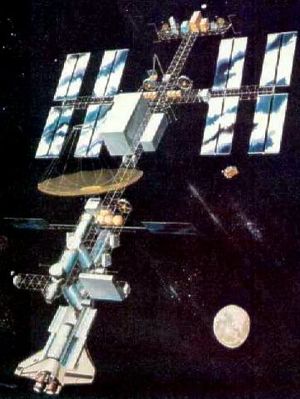 Martin Station-'84 Credit: NASA via Marcus Lindroos |
Status: Design 1984.
In the face of Pentagon opposition, NASA promised Reagan that the first two years of the project would be low-cost definition studies and agreed to develop a facility that would cost no more than $8 billion at 1984 rates. The foot was in the door, and by 2005 Reagan's space station had metastized into the International Space Station, still not complete at a cost of over.
Despite strong opposition from other Reagan Administration officials (most notably science advisor George Keyworth and Secretary of Defense Caspar Weinberger), the President finally approved the space station project in January 1984. Two years of determined NASA lobbying had finally paid off. Scientists and the military were opposed to the project, however, so NASA promised Reagan that the first two years of the project would be devoted to low-cost definition studies. NASA had agreed to develop a facility that would meet certain requirements while costing no more than $8 billion at 1984 rates. The main justifications for the Space Station project were 'jobs and foreign policy prestige.' In his January 1984 speech, the President directed NASA to invite 'America's friends and allies' so that 'we can strengthen peace, build prosperity, and expand freedom for all who share our goals.' Reagan showed the Space Station model to the other G7 leaders at the London economic summit in June 1984.
Under the 1984 plan, the Space Station would be launched in 1991-92. The initial Station would cost $11 billion ($8 billion at 1984 rates) including two unmanned free-flying platforms dedicated to astronomy and Earth observation. The international partners were expected to contribute another $2-3 billion on top of the American investment. The Station's long term funding plan called for $0.235 billion in Fiscal 1985, $0.335 billion in 1986, about $1.2 billion in 1987, and about $2 billion per year in 1988-91 (all figures in 1984 dollars). During the growth phase -- which had not yet been approved -- NASA expected to spend an additional $16 billion by 2002 to add a space tug for missions to geostationary orbit and the Moon. The crew capability would also be expanded from 6-8 astronauts to 12-18. After 2000, the Space Station would evolve into a space harbor in low Earth orbit for lunar and planetary missions as well as commercial exploitation of space resources.
Man-tended platforms would have co-orbited with the main Station complex or placed in polar orbits. But these were cancelled in 1987 and 1990 respectively. In fact, the role of cheap unmanned platforms versus a large permanently manned base was hotly debated in Congress throughout the 1980s. Powerful House and Senate leaders such as Edward Boland, William Proxmire and William Green wanted a less expensive, semi-permanently manned 'build it by the yard' platform that would be launched sooner. NASA, however, had institutional reasons for doing a large international Space Station since it provided more work and funding for its space centers and the Space Shuttle program.
Eight concepts were identified as most promising by NASA's Station Concept Development Group after the results of the 1982 contractor studies had been analyzed. In March 1984, the Station Concept Development Group reduced the list to four concepts -- the 'CDG 1 planar-array', 'streamline T', 'triangular delta-truss', and 'power tower'. A fifth, the 'spinning array', was retained as a candidate for a space resource module.
- The Johnson Space Center's 'Racetrack' configuration was loosely based on the earlier Space Operations Center concept. NASA/JSC 'Racetrack' growth configuration included a space tug hangar and satellite servicing facilities. This concept was abandoned fairly early, however.
- The 'Spinning Array' was a rotating design with despun crew modules for microgravity work; the concept was intended mainly for attitude stabilization. This design was rejected as a candidate for the Space Station itself but briefly retained as a resource module candidate.
- The Marshall Space Flight Center's 'CDG Planar' design was quite similar to the final International Space Station concept chosen in 1993. This was one of the rejected 'Final Four' designs.
- The 'Delta' design consisted of a large triangular truss structure with solar panels mounted on top and pressurized crew modules at the bottom of the structure. It would have required a considerable amount of in-orbit assembly. The 'Delta' design could later have evolved into a major orbital spaceport since the triangular structure provided a natural service hangar. This was one of the rejected 'Final Four' designs.
- The 'Big T' was a gravity gradient-stabilized design consisting of pressurized crew modules mated to a T-shaped solar array structure. This 'Final Four' design was rejected in favor of the 'Power Tower' in June 1984.
Article by Marcus Lindroos
Family: Space station, USA - Space Stations. Country: USA. Launch Vehicles: Proton-K, Space Shuttle. Agency: NASA.
 | Station Predecessors Space Station Mission Plan - 1984. Credit: NASA via Marcus Lindroos |
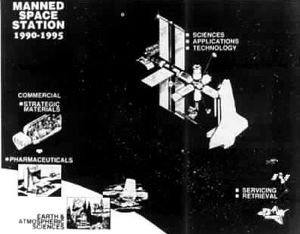 | Station Plan-1990-95 Space Station Mission Plan - 1984. Under the 1984 plan, the Space Station would be launched in 1991-92. Credit: NASA via Marcus Lindroos |
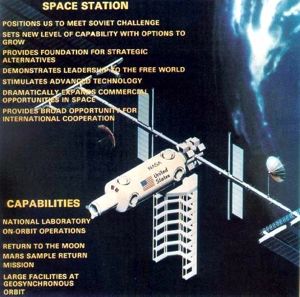 | Station Plan - 1984 Space Station Mission Plan - 1984. Credit: NASA via Marcus Lindroos |
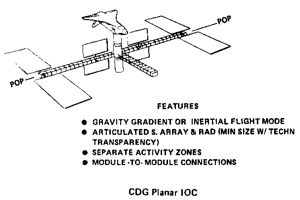 | Planar Station-1984 1984 Space Station Options - Planar. Credit: NASA via Marcus Lindroos |
 | Delta Station - 1984 1984 Space Station Options - Delta Station. Credit: NASA via Marcus Lindroos |
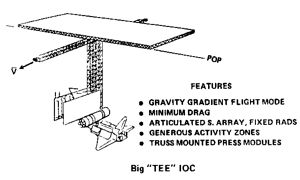 | Big T Station - 1984 1984 Space Station Options - Big T Station, 1984 Credit: NASA via Marcus Lindroos |
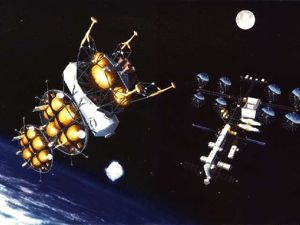 | Luna Transit Station NASA Station used to assemble lunar vehicles, 1984. Credit: NASA via Marcus Lindroos |
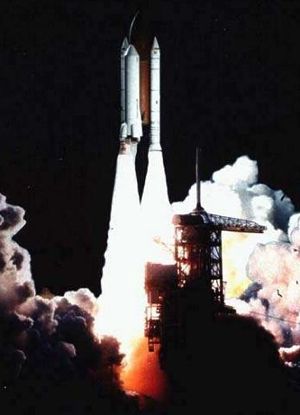 | Shuttle C 1989 Credit: NASA via Marcus Lindroos |
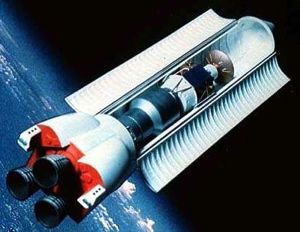 | Shuttle C 1989 Credit: NASA via Marcus Lindroos |
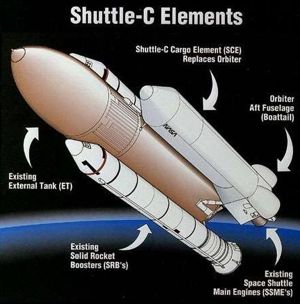 | Shuttle C 1989 Credit: NASA via Marcus Lindroos |
 | Manned Flight Trends Cumulative Total Manned Spaceflight Hours 1961-2006 Credit: Marcus Lindroos |
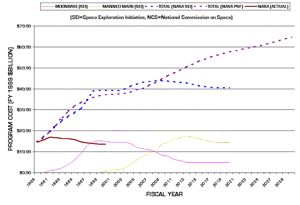 | Spaceflight Budget Actual NASA budget vs that required for various ambitious space plans Credit: NASA via Marcus Lindroos |
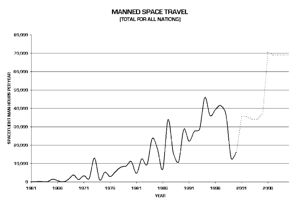 | Manned Flight Trends Annual Total Manned Spaceflight Hours 1961-2006 Credit: Marcus Lindroos |
Back to top of page
Home - Search - Browse - Alphabetic Index: 0- 1- 2- 3- 4- 5- 6- 7- 8- 9
A- B- C- D- E- F- G- H- I- J- K- L- M- N- O- P- Q- R- S- T- U- V- W- X- Y- Z
© 1997-2019 Mark Wade - Contact
© / Conditions for Use
